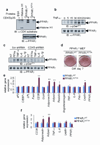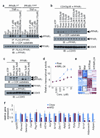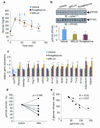Anti-diabetic drugs inhibit obesity-linked phosphorylation of PPARgamma by Cdk5
- PMID: 20651683
- PMCID: PMC2987584
- DOI: 10.1038/nature09291
Anti-diabetic drugs inhibit obesity-linked phosphorylation of PPARgamma by Cdk5
Abstract
Obesity induced in mice by high-fat feeding activates the protein kinase Cdk5 (cyclin-dependent kinase 5) in adipose tissues. This results in phosphorylation of the nuclear receptor PPARgamma (peroxisome proliferator-activated receptor gamma), a dominant regulator of adipogenesis and fat cell gene expression, at serine 273. This modification of PPARgamma does not alter its adipogenic capacity, but leads to dysregulation of a large number of genes whose expression is altered in obesity, including a reduction in the expression of the insulin-sensitizing adipokine, adiponectin. The phosphorylation of PPARgamma by Cdk5 is blocked by anti-diabetic PPARgamma ligands, such as rosiglitazone and MRL24. This inhibition works both in vivo and in vitro, and is completely independent of classical receptor transcriptional agonism. Similarly, inhibition of PPARgamma phosphorylation in obese patients by rosiglitazone is very tightly associated with the anti-diabetic effects of this drug. All these findings strongly suggest that Cdk5-mediated phosphorylation of PPARgamma may be involved in the pathogenesis of insulin-resistance, and present an opportunity for development of an improved generation of anti-diabetic drugs through PPARgamma.
Conflict of interest statement
Figures





Comment in
-
Obesity: New life for antidiabetic drugs.Nature. 2010 Jul 22;466(7305):443-4. doi: 10.1038/466443a. Nature. 2010. PMID: 20651677 Free PMC article.
References
-
- Kershaw EE, Flier JS. Adipose tissue as an endocrine organ. J. Clin. Endocrinol. Metab. 2004;89:2548–2556. - PubMed
-
- Hotamisligil GS, Shargill NS, Spiegelman BM. Adipose expression of tumor necrosis factor-alpha: direct role in obesity-linked insulin resistance. Science. 1993;259:87–91. - PubMed
-
- Lagathu C, Yvan-Charvet L, Bastard JP, et al. Long-term treatment with interleukin-1beta induces insulin resistance in murine and human adipocytes. Diabetologia. 2006;49:2162–2173. - PubMed
-
- Steppan CM, Bailey ST, Bhat S, et al. The hormone resistin links obesity to diabetes. Nature. 2001;409:307–312. - PubMed
-
- Berg AH, Combs TP, Du X, et al. The adipocyte-secreted protein Acrp30 enhances hepatic insulin action. Nat. Med. 2001;7:947–953. - PubMed
Publication types
MeSH terms
Substances
Associated data
- Actions
Grants and funding
- U54 MH084512/MH/NIMH NIH HHS/United States
- K99 DK087853/DK/NIDDK NIH HHS/United States
- DK31405/DK/NIDDK NIH HHS/United States
- ImNIH/Intramural NIH HHS/United States
- R37 DK031405/DK/NIDDK NIH HHS/United States
- R01 DK031405/DK/NIDDK NIH HHS/United States
- R01 GM084041/GM/NIGMS NIH HHS/United States
- U54-MH084512/MH/NIMH NIH HHS/United States
- DK087853/DK/NIDDK NIH HHS/United States
- R00 DK087853/DK/NIDDK NIH HHS/United States
- S10 RR027270/RR/NCRR NIH HHS/United States
- R01-GM084041/GM/NIGMS NIH HHS/United States
LinkOut - more resources
Full Text Sources
Other Literature Sources
Medical
Molecular Biology Databases

